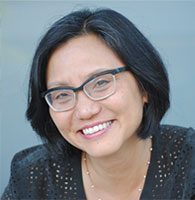Out of the Slush

Linda Sue Park
(photo by Sonya Sones)
One Writer’s Story
No two writers take the same path to that first book acceptance.
My experience is not meant to be a road map for anyone else. I decided to write about it here because it’s one of the questions I get asked most often (after “Do you have an agent?”), and perhaps there are parts that other writers will be able fit into their own maps.
I finished writing my first middle grade novel in the summer of 1997. I did not have an agent at that time; I had never been to a writing conference; I had NO connections to anyone in the book industry. So here’s what I did next:
- When the manuscript was completed, I went to the bookstore and the library. I searched the shelves for middle-grade historical fiction books. I made a list of the books I liked—both the stories and their “production values,” i.e., the jacket, typeface, paper, how the book looked and felt overall. In each case, I made a note of the book’s publisher. This step took about two weeks altogether, four or five library/bookstore visits. My list had more than two dozen publishers on it.
- I compared the publishers on my list to the entries in the Children’s Writers and Illustrators Market and the Children’s Book Council website. I crossed off any publisher who was accepting only agented manuscripts. That still left me with twenty houses. Using those two resources, I found an editor’s name at each house.
- I arranged those twenty names into a “wish list,” starting with my ‘dream’ publishers.
- I sent a query letter (see How I write queries and cover letters) and three sample chapters to the first six on my list. If all of them turned me down, I would send another batch out to the next six, etc.
- I was very fortunate: Each of the first six houses requested the full manuscript. In the cover letter sent with the manuscript, I stated that the submission was simultaneous.
My first three responses were (very nice) rejections. The fourth response was the acceptance via a phone call from Dinah Stevenson at Clarion Books (and yes, it was the most exciting phone call I’ve ever received!).
I then wrote to the remaining two houses to withdraw the manuscript from consideration and received letters from both of them, expressing disappointment in the withdrawal and asking me to submit more work. (This is why I believe in informing editors that a submission is simultaneous. I don’t think those two letters would have been as gracious had I kept this information from the editors.)
These days you often hear that it’s “impossible” to get published without an agent, without going to conferences, without some sort of personal connection to someone in the industry.
There’s no doubt that all of those things can make it easier. But my experience is proof that an unknown and unconnected writer can break out of the slush: Seesaw Girl was published in the fall of 1999.
back to “Getting Published”
—Linda Sue Park, March 2001
